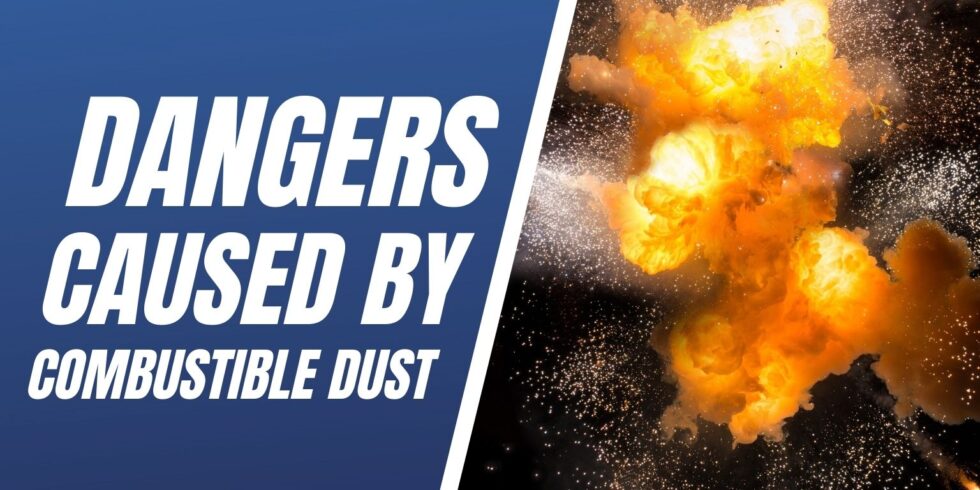
As we continue to make our way through spring and into the summer months, it is time to start planning for your facility’s industrial cleaning. Many manufacturing facilities will close for the summer months due to these maintenance and cleaning services. So, the machinery will be stopped and there are no employees to work around. One important service that is perfect for this time is combustible dust remediation. So, why is combustible dust cleaning so important? Well, for that answer we have to look at what the dangers caused by combustible dust are. To start, what is combustible dust and how does a combustible dust explosion happen?
NFPA 654 defines combustible dust as “A combustible particulate solid that presents a fire or deflagration hazard when suspended in air or some other oxidizing medium over a range of concentrations, regardless of particle size or shape.”
As an industrial facility, you produce a lot of dust and, after a while, that dust begins to accumulate on the surfaces of machinery, rafters and ceiling, ductwork, and even on the floor. When the dust is disrupted from air movement in the building, exhaust from machinery, using compressed air, or even from smaller fires or explosions nearby it disperses into a dust cloud. Since the dust cloud is contained by the walls of the building it is a fuel source. This poses a danger because an ignition source created (usually from heat, or sparks) within reach of the cloud can cause an explosion. So, then what are the dangers cause by combustible dust?
Top 4 Dangers Caused By Combustible Dust
-
Dust Creating Combustible Dust Explosion
The first and most obvious danger is the combustible dust explosion itself! Now, for a fire to burn it needs three elements present simultaneously: Fuel, Ignition, and Oxygen – also known as the “Fire Triangle”. But for a combustible dust explosion, two additional elements are needed to form what is known as the “Dust Explosion Pentagon”. These two elements are Confinement and Dispersion. They are created when the fuel, in this case combustible dust, is spread out as a dust cloud within a closed area, such as a factory or warehouse. Taking away even one of these elements can remove the risk of a dust explosion; however, the risk for a fire can still be present.
Many types of dust become explosive under the right conditions, and there have been numerous cases of uncleaned dust coming into contact with an ignition source and exploding. The “Dust Explosion Pentagon” has been created to explain how these explosions form and how to prevent them, and OSHA and the NFPA have been developing new codes to help combat this issue.
-
Dust Creating HVAC System Issues
Dust can stay in the air for days, depending on its size, and over time will be brought into the ventilation ductwork as air flows through the building. The dust will begin to settle in sections of the ventilation where there is anything that might begin to snag the dust flowing past. This can lead to significant accumulations of potentially explosive dust, even if the rest of the building appears clean and safe.
Accumulated dust can pose as a fire hazard. Dust is flammable and a fire can start from a spark of energy, or an extremely hot surface. The more dust build up there is, the more chances there are for a fire to happen. According to NFPA 654, cleaning is needed immediately “whenever a dust layer of 1/32- inch thickness accumulates over a surface area of at least 5% of the floor area of the facility or any given room.” The same rule applies when it comes to cleaning a facility’s ductwork.
-
Dust Creating Quality Control Issues
Dust on the floor is a sign that there is dust elsewhere in the building, including high up and out-of-sight areas. When the dust has accumulated on high surfaces or even in the ductwork, it can be disturbed by the vibrations of the machinery below. This can cause the dust to fall onto the machinery and production equipment, creating quality control problems and even damaging the machinery.
-
Employee Health Risks and Accidents
Dust particles 2.5 microns or smaller are able to get into the lower sections of people’s lungs, where they can’t be brought up or dissolved in the bloodstream. These particles can cause health issues such as allergies, respiratory problems, lung disease, and in some cases even cancer. Even bigger pieces of dust can cause allergies and illness in workers.
Dust can also be a slipping hazard when it collects on walking surfaces; the small particles reduce the traction that people are used to when walking in a building. Slips are one of the main causes of workplace injury, and within those injuries dust is one of the main causes of those slips.
Unfortunately, combustible dust remediation is regularly not a part of an industrial facility’s cleaning plan, because not enough people realize that the dust created from manufacturing can become an explosion hazard. In fact, the first time many people learn about the risk is as they are being handed a citation by an OSHA inspector, or worse, after an explosion has already occurred.
For more information about the dangers caused by combustible dust, Contact Us Here or call 888-845-3952 to fin out how Hughes Environmental can help you with your facility’s combustible dust cleaning.

